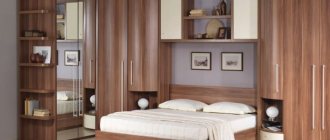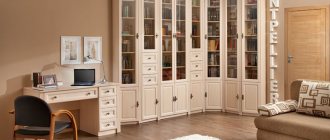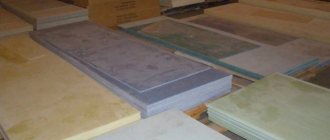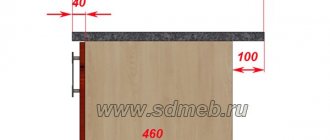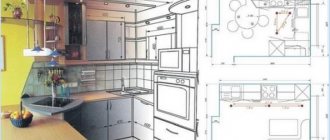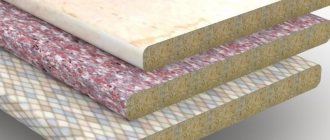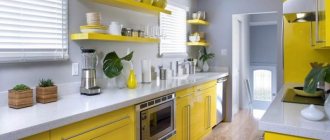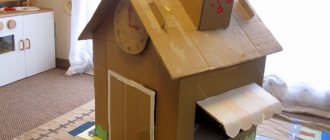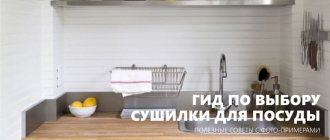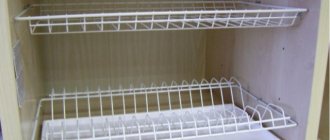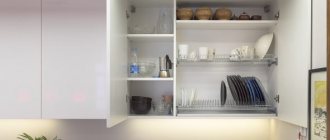Correctly calculating the dimensions of a kitchen countertop even at the design stage will help you draw up a competent drawing, determine the exact consumption of materials, and, therefore, avoid many mistakes and not lose money.
Tabletop - a cover installed on top of cabinets and cabinets of the lower tier of the set. Surfaces can be angular or frontal (installed in one direction).
Today, this element is not only a convenient place for preparing food, but also carries an aesthetic component. Attractive design is created by various types of materials: natural stone, wood, etc.
Each material has its own established standard sizes. But for a more precise understanding, let’s define the main parameters of the product.
- width (or depth) - a segment from the wall to the edge;
- length – the length of the working surface (excluding the stove, sink);
- thickness - a segment in the cross section of the tabletop.
When designing, you must also take into account the possibility of dividing the tabletop into parts and the formation of seams in connection with this - joints between parts of the whole product (always present in corner models).
Standard kitchen countertop sizes
Previously, all kitchen tables were made exclusively to the same standards. It was versatile and practical, there was no need to worry about not having enough space in the kitchen. Today, it was decided to abandon such conservatism; now ordering the production of any kitchen set from a furniture showroom is not a problem. However, a large number of the population live in standard housing, and, accordingly, use standard-sized furniture.
Countertop color and material
So, the issue with the size of the tabletop has been resolved. The next point is choosing the color of the future headset. As a rule, even if the kitchen project has not yet been developed, the buyer already knows what color he would like to see his kitchen room in. The correct choice of color is extremely important, since the tabletop can set the overall background for the room. When choosing a color, you should pay attention to the general colors of the interior and the lighting of the room.
Once the color is chosen, you can move on to the countertop material. In this matter, everything depends on the budget. It is worth noting that even with a modest financial investment you can get a relatively high-quality and durable headset. Therefore, you should choose carefully and carefully.
The material of the tabletop and its dimensions are directly dependent on each other. For example, laminated chipboard countertops are available in standard sizes - 3500 mm. The same is true for chipboard countertops, the maximum size of which is 3000 mm. However, these dimensions are only relevant for standard countertops. To order, you can make a tabletop from almost any material and size.
- Laminate countertops have a fixed depth of 600 mm. You can cut it, but you can’t increase it.
- Acrylic countertops have no size restrictions - their shape will entirely depend on the wishes of the customer and his financial capabilities. The undoubted advantage of acrylic countertops can be considered the aesthetic qualities of the material - the joints between the parts of the set are practically invisible.
- Steel worktops also have a limited depth of 600 mm. Their length may vary, but joints are difficult to avoid.
If you are aiming to purchase a standard countertop, then the choice of material is very wide. If the kitchen is made according to an individual project, then there are not many materials from which a custom-made countertop can be made.
additional characteristics
In addition to material and dimensions, there are other important parameters that affect the appearance and cost of the finished product.
- End Finishing – Standard edge finishing is included in the cost of the tabletop itself. But if you want a curly seal, you will have to fork out more.
- Connection of parts - fragments are combined by using a T-shaped profile made of aluminum alloy or joint-to-joint with or without a euro-cut tabletop. Each option has pros and cons, so you need to decide this issue for yourself “on shore”.
- Type and color of coating – a matte surface is more practical than a glossy one. This applies to any base. The dark color looks impressive, but is difficult to maintain on a daily basis.
- The presence of sharp corners - the fewer sharp protrusions, the more convenient it is to move around the room. This is especially true for a small area.
Ease of use
Of course, the color and material of the countertop play an important role. However, in the end, the deciding factor in purchasing a particular model should be ease of use. In order not to make a mistake, first pay attention to the height and build of you and your loved ones. The table should have maximum convenience not only as a surface on which food is prepared, but also as a place for eating. It is important to choose suitable chairs for the table. There should be no obstacles or inconveniences when you sit at the table or leave the table. Enough free space must be left for the legs. So, for a tall person, you should not opt for tabletops that are too narrow, and short people should not increase the standard size of the tabletop (otherwise you will have to reach far to the main dish in the center of the table).
Style selection
It is important that the countertop becomes one with the design and interior of the kitchen space and does not fall out of the overall harmonious picture and atmosphere of the room.
For example, surfaces made of natural wood perfectly complement a room decorated in a country, Scandinavian or classic style. The cold shine of the metal is suitable for a high-tech kitchen. And stone (natural and artificial) complements a classic or loft kitchen well.
Acrylic and natural stone
The use of acrylic or natural stone for the manufacture of countertops allows you to create furniture of almost any shape and size. However, the cost of such services will be significantly higher compared to plastic countertops. As a rule, such tables are installed in rooms with a non-standard layout. For example, such countertops are convenient for framing the corners of a room. The disadvantages of acrylic and natural stone include their impressive weight. The materials are quite difficult to process, which determines the price of the tabletop. In terms of processing and installation, plastic countertops are much more convenient, although they have a much more unassuming appearance.
| Stone thickness | Wholesale price | Retail price |
| 6 mm | 70 $\m2 | 80 $\m2 |
| 12 mm | 90 $\m2 | 100 $\m2 |
| Marble series 12 mm | 120 $\m2 | 130 $\m2 |
Results
To make it easier to understand how to choose the right countertop, look at this table comparing the main types and their characteristics. We will conduct the assessment, as in school, using a five-point system, where 5 is the best mark.
| Material | Consumer properties | Easy to install | Raw material safety | Price |
| laminated chipboard | 3 | 5 | 2 | 5 |
| MDF | 3 | 5 | 5 | 5 |
| Tree | 3 | 4 | 5 | 4 |
| Acrylic | 4 | 3 | 5 | 3 |
| Agglomerate | 5 | 2 | 5 | 2 |
| Stainless steel | 4 | 4 | 5 | 4 |
| Glass | 4 | 4 | 5 | 3 |
| Ceramics | 3 | 2 | 5 | 3 |
| Marble | 3 | 3 | 5 | 2 |
| Granite | 5 | 2 | 5 | 2 |
Now you just have to decide for yourself which parameters are most important and decide on the price segment.
For myself, I realized that if finances allow, then I will install an agglomerate in my future apartment. In the case of budget repairs, I will choose MDF; after all, it is non-toxic and more stable than chipboard.
What kind of countertop do you have? Would you choose her again, why?
Blade thickness
Having mentioned weight, we can’t help but say a few words about the different thickness options for kitchen countertops. There are several options, but in kitchens they mainly use moisture-resistant ones with a thickness of 38 mm. However, there are also models with a width of up to 60 mm.
Acrylic worktops can vary greatly in the thickness of the front strip, however the standard sheet of material is 12mm thick. To increase the thickness, use plywood or chipboard - with their help, the tabletop takes on a more solid appearance.
As for such a material as glass. Glass countertops vary significantly in thickness. Thus, a glass dining table, as a rule, has a thickness of about 8 mm, and a glass work surface should be at least 16 mm thick. In some models, the working surface is additionally reinforced with a backing for greater strength.
In a stone countertop, the thickness and depth parameters vary based on the purpose of this piece of furniture. Relatively thin models are suitable for use in the dining area. If the canvas is intended to be used as a work surface, the tabletop must be thick and durable enough, this will be the key to reliable operation of the product for many years. However, it is not worth equating durability with thickness. Any table, even the thickest one, is subject to mechanical deformation. For example, a tabletop made of laminated fabric can easily be damaged, since the thickness of the plastic itself is only a few millimeters. Therefore, the headset should be used carefully.
Price list
Countertops made of artificial stone “BIENSTONE”
| Product type | Series | Cost per 1 running meter | Cost of countertop 3000*600*38 |
| Tabletop 3000*600*38 without MDF | G.B. | 14630 | 43890 |
| G.M.A. | 16100 | 48300 | |
| L.J. | 17490 | 52470 | |
| Tabletop 3000*600*38 with MDF 16mm. | G.B. | 15340 | 46020 |
| G.M.A. | 16770 | 50310 | |
| L.J. | 18200 | 54600 |
- The price includes: two cutouts (for the hob and sink) and installation.
- Maximum size 3500*600*38 mm.
- Curvilinearity +20% to the cost of the tabletop.
- Kitchen sink in the color of the countertop (LJ series does not bend) Price on request.
Countertops made of Technistone stone (Quartzite)
| Product type | Decor category | Cost per 1m2. (RUB) | The cost of the countertop is 3000*600*30 (rub.) |
| Table top 3000*600*30 | 1 category | 31917 | 57450 |
| Table top 3000*600*30 | 2nd category | 33045 | 59480 |
| Table top 3000*600*30 | 3 category | 35850 | 64530 |
| Table top 3000*600*30 | 4th category | 39362 | 70850 |
- The cost of a countertop made of Technistone stone, a medium complexity option with cutouts for the sink and hob with insertion, installation and drilling of various holes. If a curved cut is required, it is calculated separately (+30% of the cost of the tabletop).
- It is possible to manufacture tabletops of any size, milling edges of any complexity.
- The decor category depends on the color of the stone.
Natural stone countertops
| Product type | Manufacturer | Cost per 1m2. (rub.) | The cost of the countertop is 3000*600*30.(RUB) |
| Table top 3000*600*30 | Russia Ukraine | 23611 | 42500 |
| Table top 3000*600*30 | India | 23611 | 42500 |
| Table top 3000*600*30 | Italy | 23611 | 42500 |
| Table top 3000*600*30 | China | 23611 | 42500 |
| Table top 3000*600*30 | Norway | 29083 | 52350 |
| Table top 3000*600*30 | Brazil | 29083 | 52350 |
| Table top 3000*600*30 | Brazil Verde Lapponia | 39983 | 71970 |
| Table top 3000*600*30 | 67285 | 121110 |
- The cost of a countertop made of natural stone is of medium complexity with cutouts for the sink and hob with insertion, installation and drilling of various holes. If a curved cut is required, it is calculated separately (+30% of the cost of the tabletop).
- It is possible to manufacture tabletops of any size, milling edges of any complexity
Plastic
Photo: usafashiontv.com
1/2
Photo: stemcellglobal.org
2/2
Plastic kitchen countertops are proving to be quite a popular material lately. They do not allow moisture to pass through, are durable if handled carefully, look good, and are inexpensive. Plastic can imitate natural materials - wood, marble, stone.
You can briefly place a hot pan or kettle on the plastic panel, clean the surface with any aggressive household chemicals, and do not be afraid of spilling water on the surface. The variety of colors and textures is so great that you can even choose an intricate print and have it applied.
Pros:
- low price,
- ease of care,
- color resistance to fading from ultraviolet radiation,
- relative heat resistance,
- resistance to household chemicals,
- resistance to humidity,
- variety of colors and textures.
Minuses:
- artificiality of the material, noticeable visually and to the touch,
- the presence of noticeable seams if the kitchen is longer than three meters.
Tabletop Liguria with edge, plastic, 807M 26mm
RUB 1,740*
Buy
*Price may change
Headset design
If you intend to independently draw up a project and assemble a kitchen set with your own hands, you need to know the standard dimensions that are used in the manufacture of kitchen furniture:
- floor standing cabinets 860 mm
- cabinets 720 mm
- cabinet legs 100 mm
- table tops = 40 mm
This is important to consider, because when you change one parameter, you need to change all the remaining ones. Ordering materials for making kitchen cabinets yourself will cost less if you use standard sizes of kitchen cabinets. Thus, the executing company will not need to create a separate layout, but can immediately begin manufacturing furniture.
